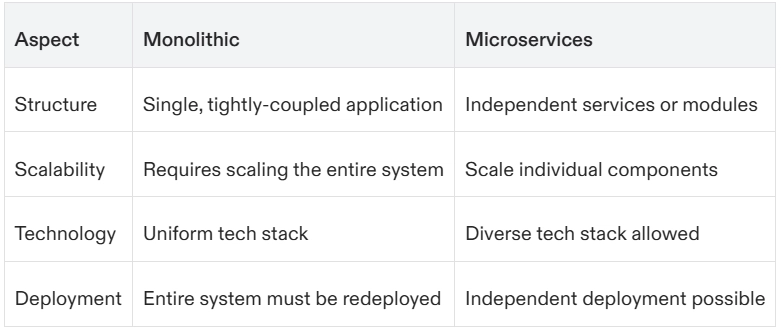Legacy systems, often critical to business operations, are increasingly at odds with the demands of modern technology. For software architects, IT managers, and tech leads, maintaining such systems can feel like running on a treadmill—you expend significant energy yet struggle to keep pace with innovation. This is where microservices architecture comes into play, providing a solution that modernizes outdated systems while unlocking benefits like scalability, flexibility, and efficiency.
Understanding Legacy Systems
*What Are Legacy Systems?
*
Legacy systems are outdated software applications or platforms that remain critical to day-to-day business operations despite their age. These systems were often developed using older technologies and architectures, such as monolithic structures, which tightly couple all components into one massive system, making updates and modifications challenging.
While they may lack the flexibility and efficiency of modern systems, legacy systems are still relied upon because they house essential data, support core business processes, or integrate with other critical tools. Replacing or upgrading them can be costly and time-consuming, leading many organizations to continue using them while exploring modernization strategies.
*Key Characteristics of Legacy Systems:
*
- Lack of Scalability: Difficulty in accommodating increased workloads.
- Obsolescence: Dependence on outdated or unsupported technology.
- High Maintenance Costs: Expensive to maintain and adapt to evolving needs.
- Limited Flexibility: Difficulty incorporating new features or integrating modern tools.
*Common Challenges Associated with Legacy Systems
*
- Organizations relying on legacy systems often face major business and technical hurdles, including:
- Performance Bottlenecks due to inflexible architectures.
- Security Risks arising from unsupported software.
- Integration Issues when attempting to adopt new technologies.
- Reduced Efficiency caused by high error rates and downtime.
*Overview of Microservices Architecture *
*What Is Microservices Architecture?
*
Microservices architecture is a system design that breaks applications into smaller, loosely coupled services. Each service operates independently, focusing on a specific business function—like order processing or user authentication.
*Core Principles of Microservices:
*
- Autonomy: Services are self-contained and maintain their own logic and data.
- Scalability: Individual services can scale without impacting others.
- Flexibility: Services can use diverse technologies or programming languages.
*Microservices vs. Monolithic Architecture
*
Monolithic architecture, while easier to design and test, requires all components to be interconnected. This means any change to one part may cause disruption across the system.
Conversely, microservices architecture isolates functional components, minimizing the ripple effect of changes. For example, in a retail company, payment processing can fail without affecting catalog browsing.
Why Modernize Legacy Systems with Microservices?
Business Drivers
- Customer Expectations: Modern consumers demand seamless experiences, which require agile and scalable systems.
- Market Competition: Staying competitive often requires adopting the latest technologies to deliver better services faster.
- Operational Efficiency: Microservices streamline workflows, reducing downtime and enabling quicker feature rollout.
- Benefits of Microservices for Modernization
- Scalability: Services can be scaled independently to handle increased demand.
- Flexibility: Each microservice can use the most suitable technology, avoiding one-size-fits-all solutions.
- Resilience: Faults in one service won’t bring down the entire system, ensuring higher availability.
- Quicker Deployments: Independent services mean faster updates and feature releases.
Assessing the Legacy System
*Evaluating the Current Architecture *
- Before transitioning to microservices, it’s crucial to assess your existing system. Key assessment steps include:
- Mapping Dependencies: Identify interconnected components.
- Analyzing Technology Stack: Review outdated frameworks and technologies.
- Spotting Limitations: Document areas where the system fails to meet business needs.
*Identifying Pain Points
*
- Common pain points to address include:
- Performance Issues like high latency and resource overhead.
- Scalability Constraints that prevent handling increased demand.
- Buggy, Complex Maintenance that drains developer productivity.
Planning the Modernization Strategy
Choosing the Right Approach
Options for migration include:
Big Bang Migration: All components are replaced at once (suitable for smaller systems).
Incremental Migration: Gradual replacement using the Strangler Fig Pattern, where monolithic components are replaced one at a time with microservices.
*Defining Service Boundaries
*
- The success of microservices lies in deciding how to decompose the monolith. Steps include:
- Identifying discrete business domains (e.g., sales, payments, shipping).
- Ensuring loose coupling to reduce dependencies.
- Maximizing cohesion within each service for unified functionality.
- Selecting the Right Technology Stack
*Evaluate tools for:
*
- Containerization (e.g., Docker).
- Orchestration (e.g., Kubernetes).
- Frameworks such as Spring Boot, Node.js, or Micronaut.
- Implementation Process
- Setting Up Infrastructure
- Establish CI/CD Pipelines for automating deployments.
- Employ containerization tools like Docker.
- Use orchestration platforms like Kubernetes for distributed system management.
*Developing Microservices
*
Key considerations include:
- Communication Mechanisms like REST APIs or gRPC.
- Data Consistency achieved via event-driven messaging (e.g., Apache Kafka).
- Data Management Strategies
Choose between:
- Database Per Service for tighter decoupling and service autonomy.
- Shared Databases for simpler integration during early migration stages.
- Security Measures
Implement:
*API-level authentication and authorization.
*
Secure service-to-service communication using protocols like TLS.
Compliance with data protection laws like GDPR.
Effective API integration is crucial for enabling seamless communication and data exchange between services in a microservices architecture. For example in travel portal development, APIs facilitate the integration of external systems, such as flight booking platforms, hotel inventory management systems, and payment gateways, ensuring real-time data synchronization and delivering a cohesive user experience.
Focus on designing RESTful APIs or GraphQL APIs tailored for efficient data exchange. Utilize versioning to manage changes without breaking existing consumers, and document APIs comprehensively to simplify integration for developers. Additionally, implement rate limiting and throttling to prevent service overload and ensure robust performance under varying loads. Employ monitoring tools to track API usage and detect potential integration issues early.
Secure API endpoints through proper authentication and authorization mechanisms, aligning with the principles described in the security measures above. By prioritizing structured and secure API integration, you can foster better interoperability and maintain the overall resilience of the system.



Top comments (0)